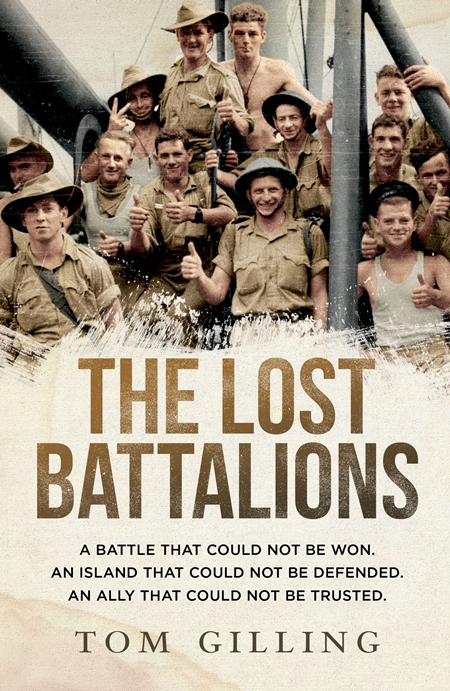Tom Gilling is best known for his books on what the booksellers refer to as ‘True Crime’ in Australia. In this book, his first in the area of Military History, he tells the story of the men of two battalions of the 2nd AIF who fought in the Middle East and in Java and who then became Prisoners of War of the Japanese.

Paperback 272pp RRP: $32.99
The two battalions who are the subject of the story are the 2/2nd Pioneer Battalion, which was raised in May 1940 and sailed for the Middle East in April 1941 on the Queen Mary and the 2/3rd Machine Gun Battalion, raised in June 1940 and sailed for the Middle East on the Ile de France – in the same convoy as the Queen Mary.
Upon arrival in the Middle East both battalions were assigned to the 7th Division and took part in the successful Syrian campaign in June and July of 1941 against the pro-German Vichy French forces. In early 1942, following Japans entry to the war, the 7th Division was recalled from the Middle East with an initial destination of the Dutch East Indies. The bulk of the men in the two battalions concerned left the Middle East ahead of the rest of the division and on the same ship, the fast troopship Orcades. After a brief stop in Sumatra the Orcades was directed to Batavia (now Jakarta) and troops from both battalions disembarked there on the 19th of February.
Shortly afterwards, following numerous robust exchanges between Curtin and Churchill, the fall of Singapore and the bombing of Darwin, it was decided that all other ships carrying the 7th division should not now follow Orcades to the Dutch East Indies but should instead return to Australia. However, as a political gesture of support to the Dutch, it was decided that the two battalions from the Orcades that had already landed in Java should remain there and be combined with a battalion from the US 131st Field Artillery Regiment and a squadron from the 3rd King’s Own Hussars to form “Blackforce” under the leadership of Brigadier Arthur Blackburn VC. Blackburn established his force with a brigade formation, utilising all the troops who had been on the Orcades as infantry with only light weapons (the 2/3rd’s machine guns had not been loaded on the Orcades when the ship left the Middle East). The task of Blackforce was to act in concert with Dutch colonial troops to defend the western end of the island of Java, with a Dutch general being in overall command of all allied forces.
The Japanese invaded Java on the night of the 28th February and Blackforce went into action a few days later at Leuwiliang, south of Batavia. They held up the Japanese advance for two days but on the 8th of March Dutch forces throughout the island surrendered and the next day Blackforce was ordered to lay down its arms.
Most of the men survived the fighting but spent the rest of the war as prisoners of the Japanese. Over 390 of the men died, most while working on the Thai-Burma Railway. Others died in POW work camps across Asia and at sea when the ships they were being transported on were sunk by allied submarines. Reading the accounts of their captivity the reader can only wonder that any of them survived the war, given that they were subject to strenuous physical labour, malnutrition, brutal beatings and diseases such as malaria, dysentery, pneumonia and cholera. As the accounts in the book make clear, many owe their survival to the work of surgeons Edward (Weary) Dunlop and Albert Coates, both of whom were captured in Indonesia. By the war’s end, the men of the two battalions were scattered throughout many locations including Java, Sumatra, Singapore, Burma, Thailand, French Indo-China, Borneo, Japan and Taiwan.
The book includes twenty-two B&W photographs, a very thorough index and a bibliography. The absence of any maps is puzzling. A map of western Java in particular, would aid the reader. Having said that, the book is well- written, and the author very skilfully connects the stories of individual soldiers with the ‘big picture’. This is a worthwhile addition to the literature on the experience of Australian soldiers in the war against Japan.
Unfortunately, there is no mention of the excellent history of the 131st Field Artillery Regiment titled The Lost Battalion by Hollis Allen, first published in 1963 – this is now available in a Kindle edition from Amazon.
Reviewed for RUSIV by Robert Dixon, October 2018
Contact Royal United Services Institute about this article.






